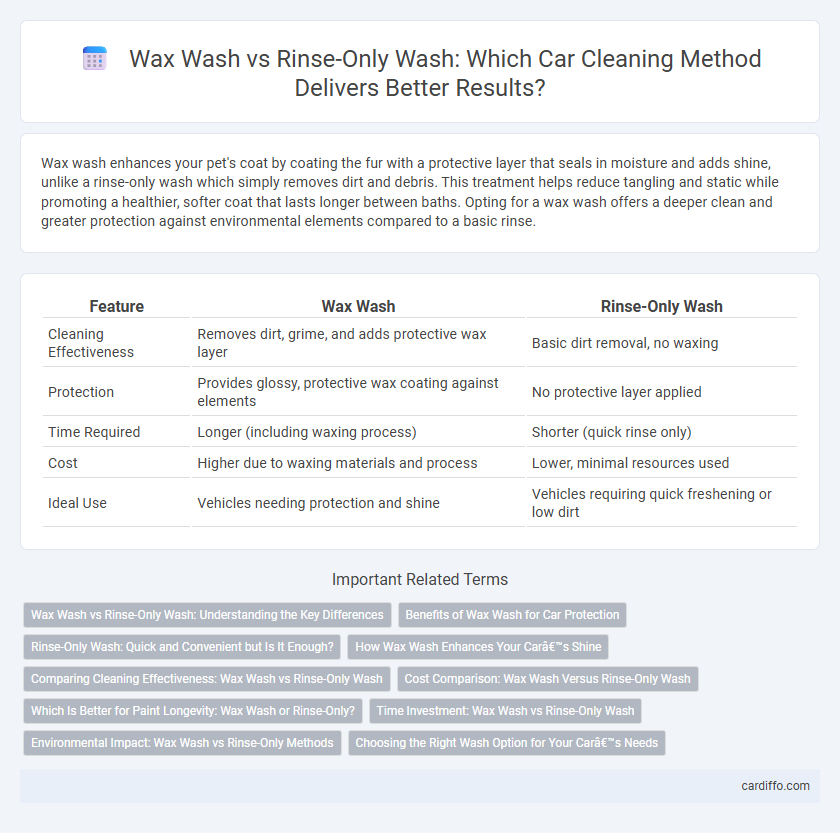Wax wash enhances your pet's coat by coating the fur with a protective layer that seals in moisture and adds shine, unlike a rinse-only wash which simply removes dirt and debris. This treatment helps reduce tangling and static while promoting a healthier, softer coat that lasts longer between baths. Opting for a wax wash offers a deeper clean and greater protection against environmental elements compared to a basic rinse.
Table of Comparison
| Feature | Wax Wash | Rinse-Only Wash |
|---|---|---|
| Cleaning Effectiveness | Removes dirt, grime, and adds protective wax layer | Basic dirt removal, no waxing |
| Protection | Provides glossy, protective wax coating against elements | No protective layer applied |
| Time Required | Longer (including waxing process) | Shorter (quick rinse only) |
| Cost | Higher due to waxing materials and process | Lower, minimal resources used |
| Ideal Use | Vehicles needing protection and shine | Vehicles requiring quick freshening or low dirt |
Wax Wash vs Rinse-Only Wash: Understanding the Key Differences
Wax wash applies a protective layer of wax to the car's surface, enhancing shine and providing longer-lasting protection against dirt and environmental contaminants. Rinse-only wash simply uses water to remove loose dirt and debris without adding any protective coating or shine enhancement. Choosing wax wash over rinse-only wash offers superior preservation of the vehicle's paint and a more polished appearance.
Benefits of Wax Wash for Car Protection
Wax wash enhances car protection by creating a durable, hydrophobic layer that repels dirt, water, and harmful UV rays, extending the vehicle's paint life. This protective coating reduces the risk of scratches and oxidation compared to rinse-only washes that merely remove surface grime without adding protective properties. Car owners benefit from less frequent wash cycles and maintain a glossy, showroom-quality finish for a longer duration through regular wax washes.
Rinse-Only Wash: Quick and Convenient but Is It Enough?
Rinse-only washes offer a fast and convenient way to refresh vehicle paint without the need for soap or wax, making them ideal for light dirt and dust removal. However, this method lacks the protective and shine-enhancing benefits of wax washes, which help shield paintwork from UV damage and environmental contaminants. For optimal car care, rinse-only washes provide a basic clean but should be supplemented with periodic wax treatments to maintain long-term paint protection and gloss.
How Wax Wash Enhances Your Car’s Shine
Wax wash creates a protective layer that locks in the car's natural shine, preventing dullness and water spots. Unlike rinse-only wash, wax wash repels dirt and grime, reducing the frequency of future washes. The added wax also enhances color depth, leaving the paint looking vibrant and glossy longer.
Comparing Cleaning Effectiveness: Wax Wash vs Rinse-Only Wash
Wax washes provide superior cleaning effectiveness compared to rinse-only washes by removing dirt, grime, and road salts more thoroughly while leaving a protective wax coating that repels contaminants and reduces water spotting. Rinse-only washes primarily use water pressure to dislodge loose debris but often leave behind stubborn residues and fail to protect the vehicle's surface from environmental damage. The added lubrication and wax layer in a wax wash enhance both cleaning performance and long-term vehicle appearance, making it a more efficient option for maintaining cleanliness and paint integrity.
Cost Comparison: Wax Wash Versus Rinse-Only Wash
Wax wash typically costs between $10 and $20 per session, offering enhanced protection and a longer-lasting clean compared to rinse-only wash, which usually ranges from $3 to $7. Over time, the higher upfront cost of a wax wash can lead to savings by reducing paint damage and the need for frequent washes. Rinse-only washes, while cheaper, may result in increased wear and potential paint deterioration, potentially leading to higher maintenance expenses.
Which Is Better for Paint Longevity: Wax Wash or Rinse-Only?
Wax wash provides a protective layer that helps repel dirt, water, and contaminants, significantly enhancing paint longevity compared to rinse-only wash. Rinse-only wash removes loose debris but lacks the protective barrier, leaving paint more vulnerable to environmental damage such as UV rays and oxidation. Regular wax wash treatments can maintain the car's finish and prevent premature paint degradation, making it the better choice for long-term vehicle care.
Time Investment: Wax Wash vs Rinse-Only Wash
Wax wash requires a longer time investment due to the additional steps of applying and buffing wax layers, typically taking 20-30 minutes per car. Rinse-only wash is significantly quicker, usually completed within 5-10 minutes, as it involves merely flushing dirt and debris without surface treatment. The time saved with rinse-only wash often comes at the expense of long-term paint protection and shine that wax wash provides.
Environmental Impact: Wax Wash vs Rinse-Only Methods
Wax wash systems use biodegradable wax-based detergents that effectively break down dirt and oils, reducing the need for harsh chemicals but may require more water compared to rinse-only methods. Rinse-only washes minimize chemical use entirely but often consume larger volumes of water, potentially leading to increased wastewater runoff affecting aquatic ecosystems. Combining water-efficient technologies with environmentally friendly detergents in wax wash systems offers a balanced approach to reducing overall environmental impact.
Choosing the Right Wash Option for Your Car’s Needs
Wax wash provides a protective layer that helps repel dirt and water, extending the cleanliness and shine of your car's exterior. Rinse-only wash is a faster, eco-friendly option that removes surface dust and grime without stripping away wax or sealant. Selecting the right wash depends on your vehicle's condition and maintenance schedule, with wax wash ideal for deep cleaning and protection, while rinse-only maintains daily cleanliness between thorough washes.
Wax Wash vs Rinse-Only Wash Infographic

 cardiffo.com
cardiffo.com